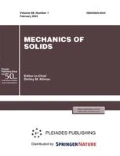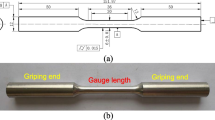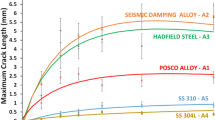Abstract
The results of experimental and theoretical studies of steel 09G2S deformation and fracture laws in a wide range of strain rates and temperature variations are given. The dynamic deformation curves and the ultimate characteristics of plasticity in high-rate strain were determined by the Kolsky method in compression, extension, and shear tests. The elastoplastic properties and spall strength were studied by using the gaseous gun of calibre 57 mm and the interferometer VISAR according to the plane-wave experiment technique. The data obtained by the Kolsky method were used to determine the parameters of the Johnson-Cook model which, in the framework of the theory of flow, describes how the yield surface radius depends on the strain, strain rate, and temperature.
Similar content being viewed by others
References
J. S. Rinehart and J. Pearson, Behavior of Metals Under Impulsive Loads (Cleveland, Ohio, 1954; Izdat. Inostr. Lit., Moscow, 1958).
G. I. Kanel, S. V. Razorenov, A. V. Utkin, and V. E. Fortov, Shock-Wave Phenomena in Condensed Media (Yanus-K, Moscow, 1996) [in Russian].
H. Kolsky, Stress Waves in Solids (Clarendon Press, Oxford, 1953; Izd-vo Inostr. Lit., Moscow, 1955).
H. Kolsky, “Studies of Mechanical Properties of Materials at Large Rates of Loading,” Proc. Phys. Soc. B 62, 676–700 (1949) [in Mechanics (Russ. Transl.), No. 4 (Izd-vo Inostr. Lit., Moscow, 1950), pp. 108–119].
A. M. Bragov, A. K. Lomunov, and E. E. Rusin, “Methods for Studying the Dynamic Properties of Materials Using the Hopkinson Compound Rods,” in Applied Problems of Strength and Plasticity. Algorithmization and Automatization of Solution of Elasticity and Plasticity, Vsesoyuz. Sbornik Vyssh. Uchebn. Zaved., No. 16 (Gor’kii, 1980), pp. 138–144 [in Russian]
Ya. B. Zel’dovich and Yu. P. Raizer, Physics of Shock Waves and High Temperature Hydrodynamical Phenomena (Nauka, Moscow, 1966) [in Russian].
L.M. Barker, “Laser Interferometry in Shock-Wave Research,” Exper. Mech. 12(5), 209–215 (1972).
G. I. Kanel, S. V. Razorenov, A. V. Utkin, and V. E. Fortov, Experimental Profiles of Shock Waves in Condensed Matters (FIZMATLIT, Moscow, 2008) [in Russian].
L. M. Barker and R. E. Hollenbach, “Laser Interferometer for Measuring High Velocities of Any Reflecting Surface,” J. Appl. Phys. 43(11), 4669–4675 (1972).
A. M. Bragov and A. K. Lomunov, “Methodological Aspects of Studying Dynamic Material Properties Using the Kolsky Method,” Int. J. Impact Engng 16(2), 321–330 (1995).
J.A. Zukas, T. Nicholas, H. F. Swift, et al., Impact Dynamic (Wiley, New York, 1982; Mir, Moscow, 1985).
A.M. Bragov, G. M. Grushevskii, and L. K. Olonov, “Plant for Studying the Mechanical Properties of Solids under Shock Loading,” Zavodskaya Laboratoriya, No. 7, 50–51 (1991).
G. R. Johnson and W. H. Cook, “A Constitutive Model and Data for Metals Subjected to Large Strains, High Stress Rates, and High Temperatures,” in Proc. 7th Int. Symp. on Ballistics (The Hague, The Netherlands, 1983).
G. R. Johnson and W. H. A. Cook, “Fracture Characteristics of Three Metals Subjected to Various Strains, Strain Rates, Temperatures, and Pressures,” Engng Fract. Mech. 21(1), 31–48 (1985).
H. Huh and W. J. Kang, “Crash-Worthiness Assessment of Thin-Walled Structures with the High-Strength Steel Sheet,” Int. J. Vehicle Des. 30(1–2), 1–21 (2002).
D. J. Allen, W. K. Rule, and S. E. Jones, “Optimizing Material Strength Constants Numerically Extracted from Taylor Impact Data,” Exp. Mech. 37(3), 333–338 (1997).
G. R. Cowper and P. S. Symonds, Strain Hardening and Strain Rate Effects in the Impact Loading of Cantilever Beams, Applied Mathematics Report (Brown Univ., 1958).
V. A. Ogorodnikov, E. Yu. Borovkova, and S. V. Erunov, “Strength of Some Grades of Steel and Armco Iron under Shock Compression and Rarefaction at Pressures of 2-200GPa,” Fiz. Goreniya i Vzryva 40(5), 109–117 (2004) [Comb. Expl. Shock Waves (Engl. Transl.) 40 (5), 597–604 (2004)].
N.A. Zlatin, S. M. Mochalov, G. S. Pugachev, and A.M. Bragov, “Temporal Features of Fracture in Metals under Pulsed Intense Actions,” Fiz. Tverd. Tela 16(6), 1752–1755 (1974) [Sov. Phys. Solid State (Engl. Transl.) 16, 1137–1140 (1974)].
N. A. Zlatin, G. S. Pugachev, S. M. Mochalov, and A. M. Bragov, “Time-Dependence of Metals Strength under Longevity of Microsecond During Range,” Fiz. Tverd. Tela 17(9), 2599–2602 (1975) [Sov. Phys. Solid State (Engl. Transl.)].
Author information
Authors and Affiliations
Corresponding author
Additional information
Original Russian Text © Vl.Vas. Balandin, Vl.Vl. Balandin, A.M. Bragov, L.A. Igumnov, A.Yu. Konstantinov, A.K. Lomunov, 2014, published in Izvestiya Akademii Nauk. Mekhanika Tverdogo Tela, 2014, No. 6, pp. 78–85.
About this article
Cite this article
Balandin, V.V., Balandin, V.V., Bragov, A.M. et al. High-rate deformation and fracture of steel 09G2S. Mech. Solids 49, 666–672 (2014). https://doi.org/10.3103/S0025654414060089
Received:
Published:
Issue Date:
DOI: https://doi.org/10.3103/S0025654414060089




